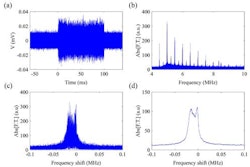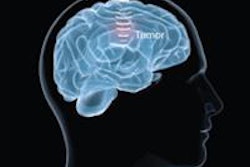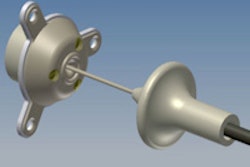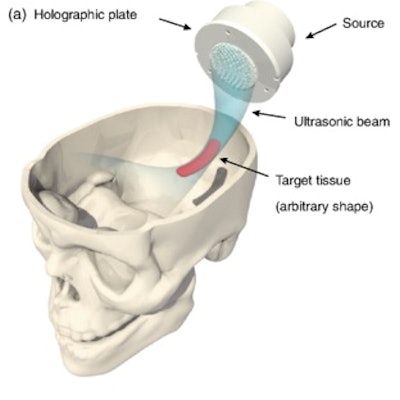
Better brain imaging, or even drug delivery, could be possible thanks to the work of researchers at the Polytechnic University of Valencia in Spain. They have developed a technique for 3D printing holographic lenses that focus ultrasonic sound waves in the brain.
Ultrasound is being used increasingly as a noninvasive therapeutic technique. It operates by focusing high-intensity waves to ablate fibroids or destroy cancerous tissue. In the case of the brain, however, this method is challenging because the skull blocks and distorts the ultrasound, preventing it from focusing on brain tissue.
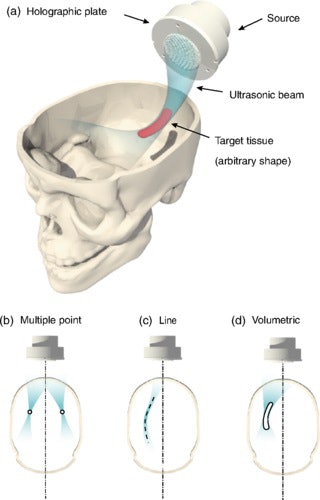 Diagram shows the holographic lens focusing over the right hippocampus. Image courtesy of S. Jiménez-Gambín et al, Phys Rev Applied (2019).
Diagram shows the holographic lens focusing over the right hippocampus. Image courtesy of S. Jiménez-Gambín et al, Phys Rev Applied (2019).Previously, scientists have tried using phased arrays to control the incoming ultrasound to correct for aberrations on penetrating the skull, but these have limited numbers of pixels and can be quite costly. Led by Noé Jiménez, PhD, scientists have now 3D printed a lens that can generate complex patterns to help refocus the beam upon penetration of the skull, allowing it to effectively target brain regions such as the hippocampus and image more clearly.
The lenses consist of a block of plastic with varying voxel sizes. Each voxel diffracts the ultrasonic wave in a slightly different way. The interference of these waves creates a hologram as they focus onto a 3D target volume within the brain.
Testing the invention
Jiménez and colleagues used a four-step process to test their approach. First, they extracted the geometry and acoustic properties of the human skull using open-source x-ray images from CT scans. They also examined soft-tissue information from the brain itself, using data from MRI. This allowed them to produce a computer model of the patient's skull and brain.
Following this step, the researchers devised a method to bend ultrasonic waves inside the skull. They used three different types of holographic focusing with increasing complexity: one that focuses the waves to a point, another that results in a curved wave path, and a third that guides the waves to flood the whole of the right hippocampus in the brain.
Next, the scientists modeled the sound waves required to create an ultrasonic hologram within the brain. By back propagating virtual acoustic fields in the brain to a point outside the skull they could calculate the phase and amplitude of the source waves needed and design a lens to produce them.
Finally, using the previously acquired CT scan and MRI data, they manufactured a 3D-printed skull phantom (a realistic brain replica), which they used to test the holographic lens. The data they obtained from the skull phantom showed good agreement with theory and simulations.
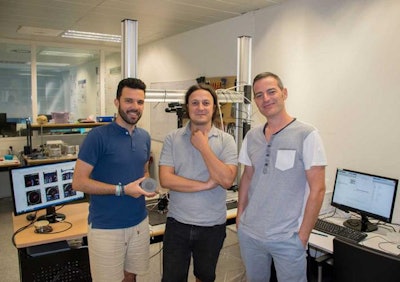 Noé Jiménez, PhD, (center) is shown with colleagues from the Polytechnic University of Valencia. Image courtesy of Noé Jiménez, PhD.
Noé Jiménez, PhD, (center) is shown with colleagues from the Polytechnic University of Valencia. Image courtesy of Noé Jiménez, PhD.Assessing the impact
Despite the good fit between the experimental data and theory and simulations, differences did arise due to the disparity in density between the printed material and bone. However, the researchers showed by using full-wave simulations that the same ultrasonic focusing would still be possible in a realistic situation.
This new concept will hopefully lead to low-cost therapy, imaging of the central nervous system, or even ultrasound-triggered neuromodulation. Perhaps, most importantly, it could also have implications for new drug delivery techniques. For example, it has the potential to open the blood-brain barrier, which typically blocks therapeutic drugs in the treatment of Alzheimer's disease.
Full details of the research are documented in Physical Review Applied (July 2019, Vol. 12:1).
Olivia Voyce is a postgraduate contributor to Physics World. Olivia is a doctoral student at the University of Liverpool, U.K., studying the use of thallium bromide radiation detectors.
© IOP Publishing Limited. Republished with permission from Physics World, a website that helps scientists working in academic and industrial research stay up to date with the latest breakthroughs in physics and interdisciplinary science.




